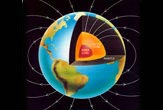
The giant orb of iron and nickel that anchors Earth's center is spinning faster than the planet's surface, according to a new study that confirms scientists' expectations.
The finding is based on analyses of earthquake pairs that occur at roughly the same spot on Earth but at different times. On seismic recoding instruments, the earthquake signatures from waveform doublets, as they are called, look nearly identical.
When earthquakes strike, their seismic waves can travel through the planet and surface all over the globe.
The researchers analyzed 18 sets of waveform doublets -- some separated in time by up to 35 years -- from earthquakes occurring off the coast of South America but which were recorded at seismic stations near Alaska.
Earth's core is made of a solid inner part and a fluid outer part, all of it mostly iron.
The solid inner core has an uneven consistency, with some parts denser than others, and this can either speed up or slow down shock waves from earthquakes as they pass through.
So the researchers speculated that if the Earth's inner core is rotating faster than the rest of the planet, then shock waves from waveform doublets would enter and exit through different parts of the core despite originating from roughly the same spot on the planet's surface.
Get the world’s most fascinating discoveries delivered straight to your inbox.
By analyzing the minute changes in travel times and wave shapes for each doublet, the researchers concluded that the Earth's inner core is rotating faster than its surface by about 0.3-0.5 degrees per year.
That may not seem like much, but it's very fast compared to the movement of the Earth's crust, which generally slips around only a few centimeters per year compared to the mantle below, said Xiaodong Song, a geologist at the University of Illinois at Urbana-Champaign and an author on the study.
The surface movement is called plate tectonics. It involves the shifting of about a dozen major plates and is what causes most earthquakes.
"We're talking about 50,000 times that of plate tectonic motion," Song told LiveScience.
The Earth can be divided into separate parts: an outer crust, a highly viscous mantle, a less viscous outer core, and a solid inner core made up of mostly iron and nickel.
Circulating magma in the molten outer core generates a weak magnetic field, which the researchers suspect may be leaking into the inner core and generating an electric current. The twisting force generated by this electromagnetic interaction may be what drives the inner core's rotation.
Song said the difference in rotation of the inner core could in turn affect the Earth's rotation and have implications for satellites, rockets and spaceships.
The study is detailed in the August 26 issue of the journal Science.
- Finally, a Solid Look at Earth's Core
- Breakthrough: New Way to Peek Inside Earth
- Hole Drilled to Bottom of Earth's Crust, Breakthrough to Mantle Looms
- Earth as a Giant Pinball Machine
The crust thickness averages about 18 miles (30 kilometers) under the continents, but is only about 3 miles (5 kilometers) under the oceans. It is light and brittle and can break. In fact it's fractured into more than a dozen major plates and several minor ones. It is where most earthquakes originate.
The mantle is more flexible – it flows instead of fractures. It extends down to about 1,800 miles (2,900 kilometers) below the surface.
The core consists of a solid inner core and a fluid outer core. The fluid contains iron, which, as it moves, generates the Earth’s magnetic field. The crust and upper mantle form the lithosphere, which is broken up into several plates that float on top of the hot molten mantle below.
SOURCE: LiveScience reporting

